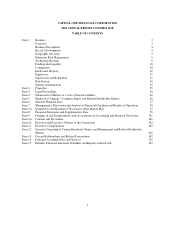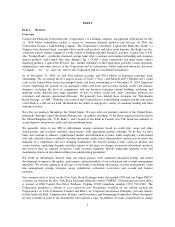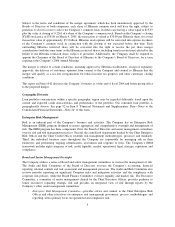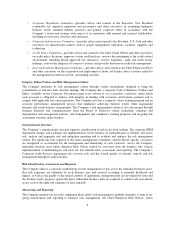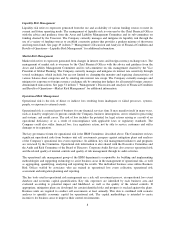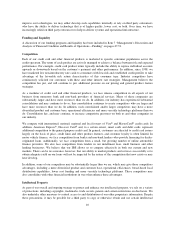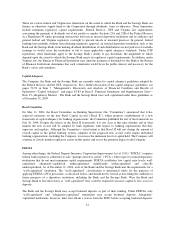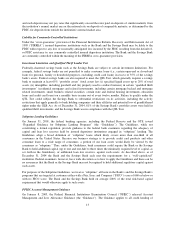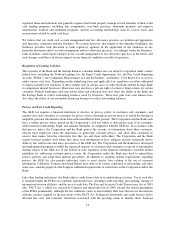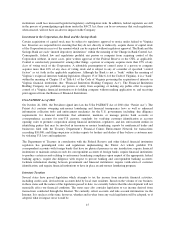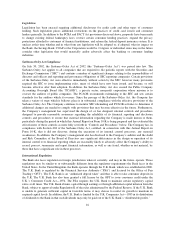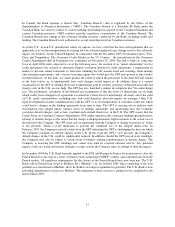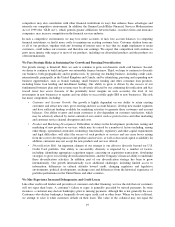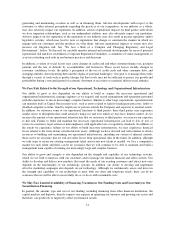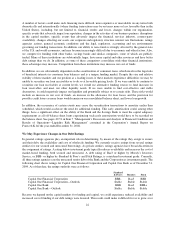Capital One 2004 Annual Report Download - page 35
Download and view the complete annual report
Please find page 35 of the 2004 Capital One annual report below. You can navigate through the pages in the report by either clicking on the pages listed below, or by using the keyword search tool below to find specific information within the annual report.There are various federal and Virginia law limitations on the extent to which the Bank and the Savings Bank can
finance or otherwise supply funds to the Corporation through dividends, loans or otherwise. These limitations
include minimum regulatory capital requirements, Federal Reserve, OTS and Virginia law requirements
concerning the payment of dividends out of net profits or surplus, Sections 23A and 23B of the Federal Reserve
Act, Regulation W under governing transactions between an insured depository institution and its affiliates and
general federal and Virginia regulatory oversight to prevent unsafe or unsound practices. In general, federal
banking laws prohibit, without first obtaining regulatory approval, an insured depository institution, such as the
Bank and the Savings Bank, from making dividend distributions if such distributions are not paid out of available
earnings or would cause the institution to fail to meet applicable capital adequacy standards. Under OTS
regulations, other limitations apply to the Savings Bank’s ability to pay dividends, the magnitude of which
depends upon the extent to which the Savings Bank meets its regulatory capital requirements. In addition, under
Virginia law, the Bureau of Financial Institutions may limit the payment of dividends by the Bank if the Bureau
of Financial Institutions determines that such a limitation would be in the public interest and necessary for the
Bank’s safety and soundness.
Capital Adequacy
The Company, the Bank and the Savings Bank are currently subject to capital adequacy guidelines adopted by
the Federal Reserve and the OTS, respectively. For a further discussion of the capital adequacy guidelines, see
pages 52-53 in Item 7 “Management’s Discussion and Analysis of Financial Condition and Results of
Operations—Capital Adequacy” and pages 82-83 in Item 8 “Financial Statements and Supplementary Data—
Note 15—Regulatory Matters”. The Bank and the Savings Bank were well capitalized under these guidelines as
of December 31, 2004.
Basel Committee
On May 11, 2004, the Basel Committee on Banking Supervision (the “Committee”) announced that it has
achieved consensus on the new Basel Capital Accord (“Basel II”), which proposes establishment of a new
framework of capital adequacy for banking organizations; the Committee published the text of the framework on
July 26, 2004. Despite the release of the Basel II framework, it is not clear at this time whether and in what
manner the new accord will be adopted by bank regulators with respect to banking organizations that they
supervise and regulate. Although the Committee’s stated intent is that Basel II will not change the amount of
overall capital in the global banking system, adoption of the proposed new accord could require individual
banking organizations, including the Company, to increase the minimum level of capital held. The Company will
continue to closely monitor regulatory action on this matter and assess the potential impact to the Company.
FDICIA
Among other things, the Federal Deposit Insurance Corporation Improvement Act of 1991 (“FDICIA”) requires
federal bank regulatory authorities to take “prompt corrective action” (“PCA”) with respect to insured depository
institutions that do not meet minimum capital requirements. FDICIA establishes five capital ratio levels: well-
capitalized, adequately-capitalized, undercapitalized, significantly undercapitalized and critically
undercapitalized. As of December 31, 2004, each of the Bank and the Savings Bank met the requirements for a
“well-capitalized” institution. The “well-capitalized” classification is determined solely for the purposes of
applying FDICIA’s PCA provisions, as discussed below, and should not be viewed as describing the condition or
future prospects of a depository institution, including the Bank and the Savings Bank. Were the Bank and
Savings Bank to lose their status as “well-capitalized” they could be required to increase capital or lose access to
deposits.
The Bank and the Savings Bank may accept brokered deposits as part of their funding. Under FDICIA, only
“well-capitalized” and “adequately-capitalized” institutions may accept brokered deposits. Adequately-
capitalized institutions, however, must first obtain a waiver from the FDIC before accepting brokered deposits,
12


